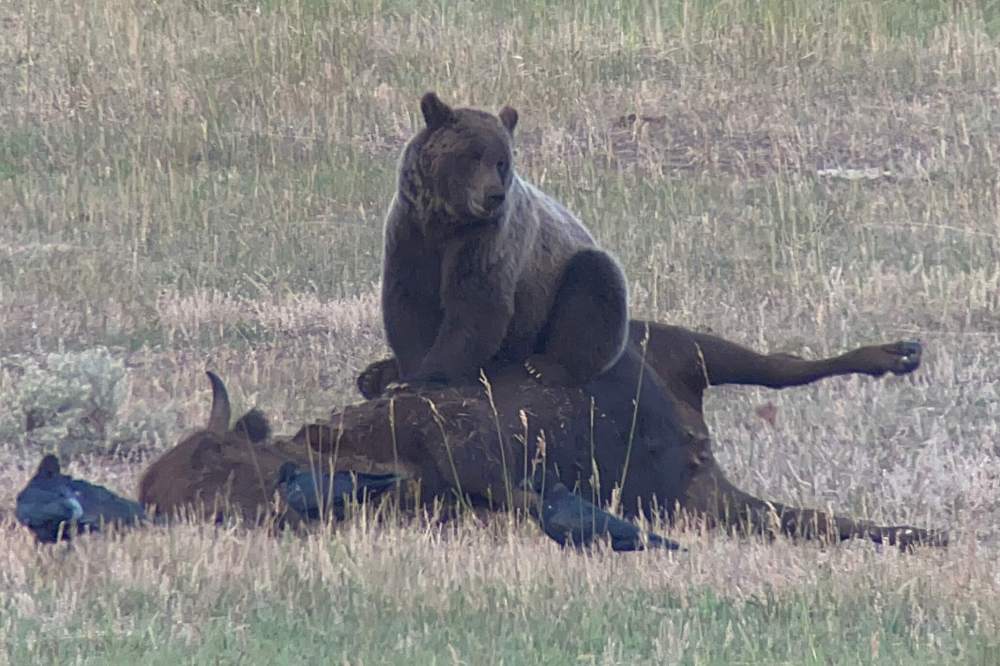Bearly Believable: The Wild World of Grizzly Bear Romance and Reproduction

Photo courtesy of Yellowstone Wild Owner/Operator Emil McCain
The world of grizzly bear romance is wild – filled with roaring, territory marking, and a little bit of bear-ing it all.
The mating season of grizzly bears is a spectacle akin to a reality TV show, but with contestants armed with claws and a taste for elk calves. From late May to early July, these charismatic creatures embark on a quest for love (albeit seasonal). Male bears, known as boars, traverse vast territories in search of a female bear, or sow, who might be interested in some summer love of her own.
In the world of grizzly bears, first impressions are everything. Boars may captivate potential mates with their deep, thunderous roars, a bear’s version of a suave pickup line or a perfectly timed joke. If a nearby sow is intrigued, she might just come over to check out the competition. Once a male and female grizzly ‘meet’, they engage in a courtship that can only be described as a bear ‘tango.’ This involves several romantic activities like sniffing, circling, and playful wrestling. It’s their way of determining compatibility, much like a first date, but with more fur and fewer awkward silences. 
Female grizzly eyeing a potential breeding partner? Photo courtesy of YW Naturalist/Photographer Evan Watts

A male bear protecting his prize and perhaps showing off for a receptive female? Photo courtesy of YW Naturalist/Photo Guide, Kyle Dudgeon
Sows don’t just fall for any old bear that roars their way. They usually play hard to get, leading the boars on a tantalizing chase through the wilderness. These chases aren’t just for fun (though it is amusing to watch); it’s a test of endurance and strength. After all, a bear that can keep up with her will likely have the genes to back up the stuff he’s strutting!

Photo courtesy of YW Owner/Operator Emil McCain
Competition is fierce, and it’s not uncommon for boars to battle it out for the attention of a single sow. These fights can be intense, with bears rearing up on their hind legs, swiping with their massive paws, and using their sheer bulk to assert dominance. It’s like a grizzly version of “The Bachelorette,” where only the strongest (and most persistent) suitor wins.
Once a pair successfully navigates the bear dating scene, they spend a brief but intense period together, usually lasting a week or two. Mating generally involves repeated copulations lasting 20–30 minutes but occasionally lasting up to an hour or more! They will mate multiple times to ensure successful fertilization, and then—like any good summer romance—they go their separate ways.
Photo courtesy of YW Lead Naturalist/Photo Guide Rob Harwood
After a female grizzly bear has conceived, implantation of the fertilized eggs is delayed until she enters her winter den. The number of cubs that are ultimately born results from the sow’s overall health—especially fat reserves—when she begins her long winter sleep. Official pregnancy and fetal development will only occur if she has enough body fat to support cub development throughout hibernation. If she doesn’t, the fertilized eggs(s) are absorbed by her body–nature’s way of ensuring she can give it another go next summer. Cubs are born inside the den in late January- early February and begin nursing and sleeping as the mother goes back to hibernating. Usually, two cubs are born, sometimes one or three, and rarely four. A grizzly bear sow this spring–caught on video with FIVE cubs of the year– is evidence of a well-fed pre-hibernation lady bruin!
Screenshot below of video (click on picture) captured by YW Lead Naturalist/Photo Guide Rob Harwood. 
Grizzly bear mating is a captivating and intricate process, a spectacle of instinct and survival that is crucial for the continuation of their species. While it may seem a bit untamed compared to human dating rituals, it’s perfectly suited to the rugged lives of these wild creatures. So, the next time you’re navigating the complexities of modern dating, take a moment to appreciate that grizzly bears do it all with a roar, a chase, some persistence, and–most likely– pretty bad breath! Who knew that in the complicated world of love, we could all learn a thing or two from our furry, fabulous, and enthusiastically fat ursine neighbors?
Blog by Yellowstone Wild Lead Naturalist Matt D.
To learn more about Matt and the rest of the Yellowstone Wild team, visit our “About Us” page


